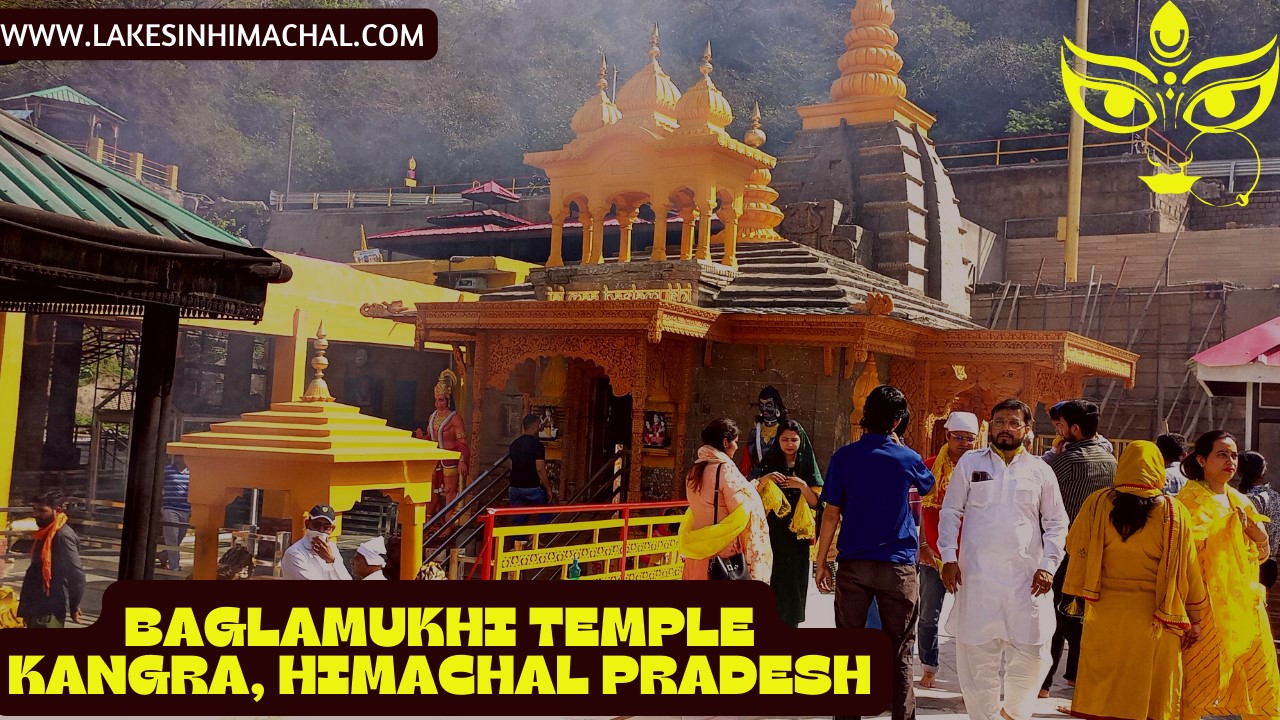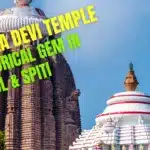If you’re in search of a place to visit which is peaceful, calm and infused with the rich heritage and culture of India, then Baglamukhi Temple in Kangra, Himachal Pradesh is a must-visit location for you and your family. This shrine is dedicated to goddess Baglamukhi which is believed to possess the ability to stop or ward off enemies. In this article, we will examine the temple’s history, its architectural, importance, religious importance and festivals as well as try to find out some other similar attractions in Kangra and nearby. We will also examine what is the best season to visit, accommodations facilities, as well as other tips that you may find useful and interesting.
Baglamukhi Bankhandi
The temple of the goddess “Baglamukhi” is located in the Bankhandi town in the Kangra district on the Chintpurni-Kangra highway. In fact the temple is located few km away from the Bankhandi town bang on the highway. There is no town of village in the near vicinity of the temple. If you are driving from Kangra on your way to Chandigarh or Punjab, the temple is on the right side. However, there is a big parking on the right side of the road. The parking has toilet facilities where you can get fresh. After parking your vehicle, you can walk towards the temple after crossing the road. Be careful while crossing the road as vehicles come from both the directions.
Mata known as Pitambari
As soon as you are nearing the temple, there are shops selling pooja (offerings) items. With the offering in you hands you walk towards the temple and when you arrive near the temple’s premises, the first thing that grabs your attention is that the place is quite huge with everything spick and span. Another thing that you notice is that everything is in yellow colour. From the ceiling fans, which are painted in yellow, the “prasad” which is yellow to the dresses of pujaris which are all in yellow color. This is the reason that the Goddess “Baglamukhi” is also known as ” Pitambari”. According to ancient beliefs and inscriptions in the temple, it is believed the Mata originated from turmeric-colored waters. Due to the yellow color of turmeric, she is also referred to as “Pitambari Devi”.
Baglamukhi Mata Himachal
As soon as you enter the main temple, there is a long queue of devotees waiting to enter the Baglamukhi Mata Mandir to be blessed by the Devi Mata. The devotees are permitted to go inside the sanctum of the temple in groups of twos or threes, one after the other. Only two people can enter side by side inside the sanctum where the pujaris will accept your offerings on behalf of the devi. After touching the devi’s feet, the prasads are returned to you. Inside the sanctum you can see goddess’s idol “Baglamukhi” , with Lord Shiva on one side and Lord Ganesha on the other side. Lord Shiva is known by the name of “Bhairav ” of Goddess “Baglamukhi”.
Reason Behind Name of Goddess Baglamukhi Mata Kangra
The story of the reason behind the name of Goddess Baglamukhi Mata Kangra is quite quite interesting. Baglamukhi” Ji was created to resolve a problem of Lord “Brahma”, the creator of all things. A demon had hid the scriptures of Lord “Brahma” in “Patal Lok” (nether world). The demon was blessed with a boon that nobody could kill him, either on the earth or in the water. When the lord “Brahma” chanted the name of Goddess “Bhagvati”, she was born as goddess “Baglamukhi”. She then went to “Patal Lok” (nether world) and defeated the demon and came back with the holy book which she gave it back to lord “Brahma”.
Baglamukhi as Kuldevi of Ravana
It is believed that Ravana demon King in Lanka Also has a particular story that is associated with the goddess “Baglamukhi”. In reality, it is believed that the temple was constructed on the orders of “Ravana” in ancient times. Baglamukhi” could also be regarded as to be the “Kuldevi” from “Ravana”. Ravana utilized to do “havan” here to please Goddess “Baglamukhi”. When Lord Rama discovered that the Lord in Ravana was Goddess Baglamukhi He also received his blessings from Goddess “Baglamukhi”. This is the reason the Lord “Rama” ordered lord “Hanuman” to be present at the entrance of the Goddess as her protector.
Origin and History of Baglamukhi Temple
It is believed that the Baglamukhi Temple is one of the oldest temples in India, dating back to the 8th century. In accordance with Hindu mythology Goddess Baglamukhi is the 8th manifestation of the ten Mahavidyas. It is also believed that temple was built during the time of the Pandavas and was later renovated by the rulers of the area. The temple has been through numerous restorations and renovation work over many centuries.
Architecture of the Temple
The Baglamukhi temple is a stunning example of ancient Indian art and architecture. The temple has a unique mix of Hindu and Buddhist styles that can be seen in its design and architecture. What sets Baglamukhi Temple from other temples in the region is its unique features. The temple is home to a huge idol of Goddess Baglamukhi which is constructed of stone. It is believed to be more than 800 years of old. The temple features a distinctive dome-shaped roof supported by four pillars. The temple is decorated with intricate sculptures and carvings which depict the goddess Baglamukhi and various other gods.
Structures of Baglamukhi Temple
In 1905 the city was struck by a massive earthquake that struck the entire Kangra district. There was destruction everywhere. However, miraculously the shrine of Mata Baglamukhi was not harmed at all. The entire temple remained intact without any damage. If you take the steps and go down the stairs, there is an old “Bankhandi Mahadev” temple there. Within the temple is a massive “Shivlinga” and the locals have a deep faith in “Bankhandi Mahadev”.
Religious Significance of the Temple
Baglamukhi Temple is thought to be among India’s most powerful shrines. It is believed that worshiping the image of the goddess can help in getting rid of negative energy and any obstacles that you may be having in your life. It is also believed that the goddess possess the ability to disarm enemies and control them. It is a place where one can be in touch with God and experience the feeling of inner peace and tranquility.
Festivals Celebrated the Temple
Baglamukhi Temple celebrates several festivals throughout the year. These festivals and celebrations are a significant aspect of the temple’s culture and customs. The most popular festivals celebrated at the temple are Navratri, Dussehra, and Diwali. In these celebrations, the temple is lit up with lights and flowers. People from all over the place and from far and wide visit at the shrine during these festivities to pray for divine blessings from the Goddess.
Havan in Baglamukhi Temple Himachal
If you look around the temple you will find havan being performed at various places in the temple premises. Bablamukhi Temple Himachal is well-known throughout India for the fire sacrifices (Havans) that take place every day. Invoking “Havan” to please the goddess is done continuously at the temple at the behest of the devotees. The havan performed at night is believed to be particularly important since it is believed it brings results in just 36 days. There are 136 kinds of havan and ceremonies held in this temple. Various “havans” are performed by various methods using different ingredients, which mostly comprises of yellow mustard, turmeric roots, black pepper, etc.
How to Perform Havan at Baglamukhi Mandir Kangra
The different havans serve different purposes such as red chili, which is believed to be a deterrent of enemies. When performing haven, the havan samagri or substances are poured using the left hand. There is a “havan kund” (fire pit) that is located right in front of the temple. The devotees who wish to have “Havan” performed, can contact the authorities in the temple premises. You will find many kiosks located at different places inside the temple complex. You can inquire for the havans and any other assistance that you require. There are different rates for performing havan. The minimum fees for performing a haven starts at Rs 3100 and upwards depending on the kind of havan or the worship you are want to be done.
Langar / Free Kitchen at Baglamukhi Mandir
There is also a “langar” (free kitchen) in the “Baglamukhi Mata Mandir” which runs from 12:00 pm until 3:00 pm. Prasads that are served here is yellow curry, yellow prasad and yellow lentils, all yellow in color.
How to Reach Baglamukhi Temple
The Baglamukhi Temple is located in village Bankhandi located about 25 km away from the city of Kangra. The temple can be reached by various modes. There are many options of transport to get there. The nearest railway station is located in Pathankot which is about 95 km from the temple. The closest airport is Gaggal located about 40 km from the Temple. If you are coming from Delhi to the Baglamukhi Temple in Kangra, Himachal Pradesh, the options to reach here are as follows :-
By Air
The nearest airport to Kangra is Gaggal Airport, which is located about 40 km from the shrine. You can fly from Delhi to Gaggal and then take taxi or local buse to reach the temple.
By Train
You can reach Pathankot via train. From there you can take a bus or taxi to get to the Baglamukhi temple. Distance between Pathankot and Kangra is around 95 kilometers.
By Road
There are regular buses that run from Delhi up to Kangra and Dharamsala. You can book bus ticket from RedBus or if you want to travel by HRTC Buses, you can go to their online website. The distance from Delhi to the mata Baglamukhi temple is approximately 500 km and takes around 10 hours journey time.
Other Places of Interest in Kangra
Baglamukhi Temple is situated in the Kangra district, which is famous for its natural beauty and rich cultural heritage. Kangra is a beautiful place that provides visitors with much more than the Baglamukhi Temple. The nearby attractions to visit are:
Kangra Fort
It is one of the most ancient forts in India and is situated about 25 km from the temple. The history of the Kangra Fort dates back to the 4th century. Once you reach here you can enjoy breathtaking views of the valley surrounding it.
Masroor rock cut Temples
These rock cut temples are situated approximately 50km from Kangra and are an UNESCO World Heritage Site. The temples were carved out of one giant rock and is believed to date to around the eighth century. The distance of Baglamukhi Temple to Masroor Rock Cut Temple is around 25km.
Dharamshala
This vibrant hill station is situated about 20 kilometers from Kangra and is renowned for its Tibetan food and culture. It is also place of residence of HH the Dalai Lama.
Palampur
The town of Palampur is situated about 40 kilometers from Kangra. This beautiful town is famous for its beautiful tea gardens and picturesque natural beauty. It is a wonderful place to unwind and relax in the lap of nature.
Chamunda Devi Temple
Chamunda Devi Temple is another renowned temple located in Kangra District, dedicated to the goddess Chamunda. This is also a must visit temple.

Jwala Devi Temple
Jwala Devi Temple is one of the most well-known temples in Himachal Pradesh. It is is dedicated to Goddess Jwala and is situated around 35 kilometers from the temple.
Baijnath Temple
This temple is dedicated to Lord Shiva and is situated around 50 km away from the Baglamukhi Temple
Best Time to Visit Baglamukhi Temple
Baglamukhi Temple can be visited anytime throughout the year. However, the best time to visit is during the Navratri festival that is celebrated in the months of April and September. The monsoon, which is between July and August is also an ideal occasion to make a trip to temple because the hills are lush green and the temperature is cool.
Weather in Kangra
The climate in Kangra is warm throughout the year. Kangra district has a moderate climate all through the year. The summers are warm and temperatures range between 22 %C to 38 % Celsius. The monsoon period, from July through September brings heavy rainfall and landslides which makes travel difficult. It is best to avoid coming here during monsoons. The winter season, which runs from December through February, can be quite cold with temperatures dropping to 0°C.
Precautions to Take During the Monsoon
In the monsoon months, it is advised to stay clear of Kangra district because of the possibility of flooding and landslides. If you do have to travel, ensure that you check the weather forecast and road conditions before undertaking the journey. If you are coming during winters, make sure you have warm clothes, since temperatures plummet drastically, particularly during the evening. It is also recommended to wear shoes that are sturdy and have an excellent grip to avoid slipping.
Accommodation and Facilities
There are few lodging facilities available close to Baglamukhi Temple. However, these are limited. There may be few hotels and guest houses in Bankhandi which is few km away. However, since Kangra is only 23 km from Baglamukhi temple, better option would be to stay in Kangra and then come here for darshan. Another option would be to visit Baglamukhi temple on your way back to Delhi to Chandigarh after your visit of Dharamsala or Kangra is over. The first time we were in Dharamsala, we visited Jawalaji Temple on our way back to Delhi. This time (April 2023) we visited Baglamukhi Temple on our way back to Delhi.
F A Q
What is the significance behind Goddess Baglamukhi?
What are the Timings for Visit in the Baglamukhi Mandir Kangra?
Is Photography allowed in Maa Baglamukhi temple Kangra?
What dress code should be followed when going to Baglamukhi Mata Mandir Himachal?
Baglamukhi Merchandise
Ma Baglamukhi Idol
The Goddess Baglamukhi is a fearsome deity who is said to be able to vanquish even the most powerful enemies. She is also known as the destroyer of black magic, and her devotees believe that she can protect them from all forms of harm.
This exquisite idol of Baglamukhi is made from panchadhatu, a blend of five metals that is said to be especially powerful. It is beautifully crafted and features a flawless finish. This idol would make a stunning addition to any home or temple, and it would also be a thoughtful gift for anyone who is looking for divine protection.
Maa Baglamukhi Vinashak Kawatch
The Vinashak Kawatch is a powerful locket that is said to be blessed by the Goddess Baglamukhi. It is believed to bring the wearer peace, happiness, popularity, power, authority, wealth, prosperity, and success. The locket is also said to protect the wearer from enemies and black magic.
This locket is made from a special blend of metals that is said to be especially effective in warding off evil. It is also inscribed with the mantra of Baglamukhi, which is said to have great power. The Vinashak Kawatch is a valuable and powerful talisman that can help to keep the wearer safe and secure.
Maa Baglamukhi Raksha Kawatch Chowki
The Raksha Kawatch Chowki is a sacred object that is said to be able to protect the wearer from all forms of harm. It is made up of a number of different elements, including images of the Goddess Baglamukhi, the Beesa Yantra, and the Baglamukhi Yantra.
The Beesa Yantra is a powerful symbol of protection, and the Baglamukhi Yantra is said to be able to control even the most powerful enemies. When these two symbols are combined, they create a powerful force that can help to keep the wearer safe from harm.
The Raksha Kawatch Chowki is a valuable and powerful object that can help to keep the wearer safe and secure. It is a must-have for anyone who is looking for divine protection.
Recent Posts
- Camping at Chandertal Lake, Himachal Pradesh: A Complete Guide
- Exploring Keylong: Your Ultimate Travel Guide
- Delhi to Manali Bus Journey: A Traveller’s Guide
- Bhrigu Lake Trek: A Himalayan Adventure from Ahmedabad
- Hampta Pass Trek: A Journey from Ahmedabad to the Himalayas
- Gobind Sagar Lake
- Chamba, Himachal Pradesh: A Comprehensive Travel Guide











